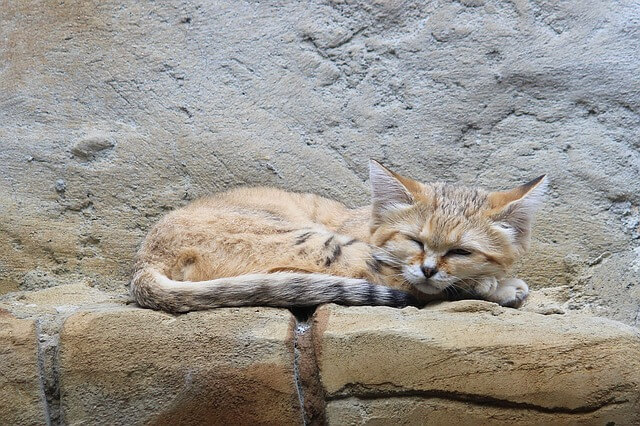Sand cat is a unusual cat that always remains like a kitten. Such felines also called sand dune cats live exclusively in hot, dry areas. Its habitats are very diverse, from sandy deserts, almost devoid of vegetation, to stony valleys overgrown with shrubs. Occasionally they live in the clay desert and on the rocky coastal ridges. Dune cats are strictly nocturnal.
Only the Pakistani subspecies are active in winter and early spring mainly at dusk. They prefer to hide from the heat of the day in shelters. They use for this old burrows of foxes, corsacs, porcupines, as well as extended minks of gophers and gerbils.
The sand cat belongs to the small cat family. The Latin name of the species is Felis margarita
Habitat
The sand cat prefers for life such climatic zones as deserts. This species lives in North Africa, the Arabian Peninsula, Iran, Pakistan and the countries of Central Asia.
The secretive way of life of this cute animal contributed to the fact that only in 1858 the French naturalist Victor Loche made the official description and classification of the sand cat.
Appearance
The sand cat is the smallest of all species of wild cats. An adult looks no more, and sometimes less than an ordinary domestic cat. The body length of the animal is 39–52 cm (15–20 in), of which 40% falls on a fluffy long tail, that can be as long as 23–31 cm (9.1–12.2 in). This kitty stands 24–36 cm (9.4–14.2 in) at the shoulder and weighs 1.5–3.5 kg (3.3–7.5 lb), the females weigh 0.5-1 kg (1-2 lbs) less.
The sand dune cats has a large, wide and slightly flat head with pronounced sideburns. The ears are wide and large, but during the pursuit of prey they can fold and lie flat against the skull. Eye color is mostly yellow ringed with white. This feline has short and strong paws, its feet are covered with hard wool that prevents the burning of the soles by the hot sands of the desert.
The animal’s fur is thick, soft and well provides the function of thermoregulation of the body
The color corresponds to the location – the color of the dune cat can be called sandy. There are darker stripes on the back and tail of it. The tip of the tail is black. The chest and chin are lighter than the whole body. Subspecies living in Central Asia have more dense fur in winter.
Lifestyle
Dune cat lives in the hottest and driest deserts of the Earth. Sometimes these are sandy deserts with almost no vegetation, sometimes these are rocky valleys covered with shrubs.
These kitties are more active at night, in rare cases – in the twilight. During the day, these animals hide from the heat in holes abandoned by foxes, marmots and porcupines. If they can’t find any suitable holes, they can dig small pits on their own or hide in crevices between the stones.
In shelter
Hunting grounds of one animal occupy an area of about 15 square meters km (738 feet). Felines can walk more than 10 km (33 thousand feet) in a day looking for food. These animals move, crouching to the ground, in small rushes and leaps. Thanks to the large and low-set ears, sand cats can distinguish even the most elusive squeak of the mouse and the sound of movement on the sand of a lizard.
Dune cats are predators, and feed on any prey which they only can catch
The main dietary of the wild animal consists of rodents (gerbils, jerboas, hares), as well as lizards and insects. Cats also do not bypass the birds and their nests and do not disdain spiders.
The ability of this animal to quickly dig burrows allows them to find reptiles and mammals deep in the sand, as well as to dig deeper and hide uneaten prey from other predators. In winter, the cat sometimes approaches human settlements, but does not hunt domestic animals and birds.
Jackals, wolves, large predator birds are the main enemies of these felines in their natural environment. Humans also hunt for a sand cat, catching wild animals for sale.
Breeding
Dune sand cats are solitary animals, and live together with someone only during the mating period. Their reproduction in natural conditions depends on the season and habitat. In the Sahara, the cat breeds in winter and spring, in Central Asia – in spring and early summer, in Pakistani and Iranian deserts – in autumn. During the mating season, the tomcat makes loud sounds, like barking, notifying the lady-cat of its readiness for procreation.
Pregnancy of an animal lasts about two months
There are from 2 to 5 kittens in a litter. At the age of two weeks cubs open their eyes, and after a month and a little kittens can participate in the hunt. The half year old sand cat can already live independently of the parents. Kitties reach sexual maturity at the age of 9-15 months.
In zoos, these wild felines can breed 2 times a year. The average life span of sand cats living in captivity is 13 years.
Position and number of species
Despite the fact that the dune cat is listed in the International Red Book with the status “Close to the vulnerable position” the species is the most prosperous among all wild cats.
The estimated abundance is 50,000 individuals. What helped Felis margarita to keep the population at this level is hard to say. Perhaps the matter is in an overly hidden lifestyle, although the manulas and Andean cats are no less secretive, but nevertheless they are two steps away from extinction.
Interesting Facts
Like the mongooses, wild dune cats can hunt snakes, including poisonous ones. They stun the snake with quick and strong blows to the head, and then they dig at it in the neck.
Another interesting feature of sand cats is their ability to survive with virtually no water, getting moisture mainly from food. Their anatomical features (the structure of the urinary system) are such that the fluid accumulates in their body in the form of a concentrate, like that of camels, and the kitty consumes it gradually as needed.
There are only nine sand cats in the various zoos of the world, all of which are descendants of one couple. Therefore, in captivity this species threatens the crossing of close relatives.
The dune cat received its scientific name after the name of the French general and researcher Magy-Diegipe
In 1855, he traveled to the Sahara, where he became the first European who saw a sand cat. It happened on the border of Libya and Algeria. As a result of this discovery, he described a new wild cat species was and called it a dune cat.
The sand cat is not the smallest African cat, that is: its close relative, the black-legged cat, has a tiny body length of only 37-50 cm (15 – 20 inches).









I wanted a sand cat as a pet cause it was sooo cute.But I guess that’s why a lot of animals end up in shelters. GOOD TO KNOW